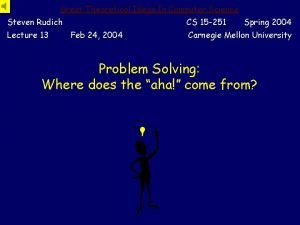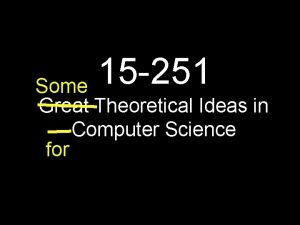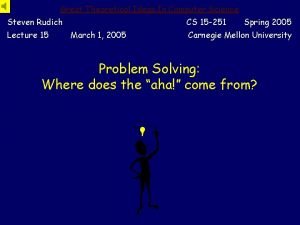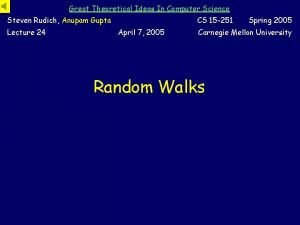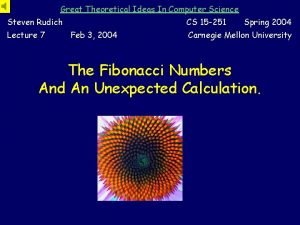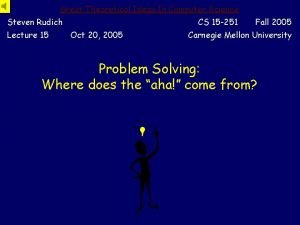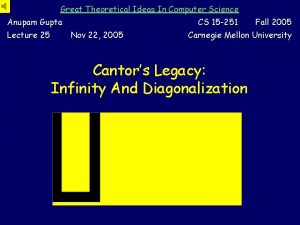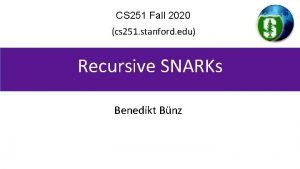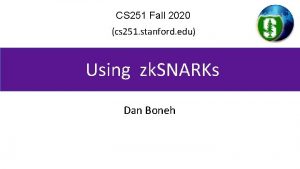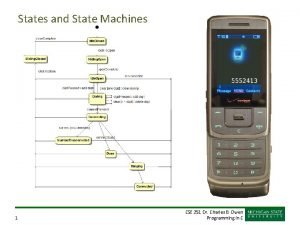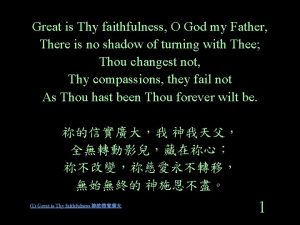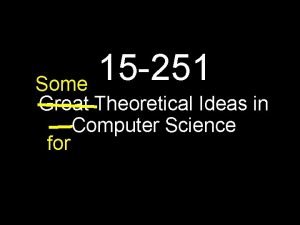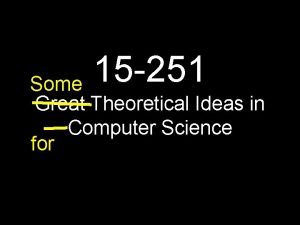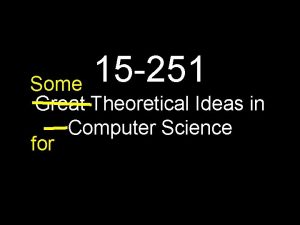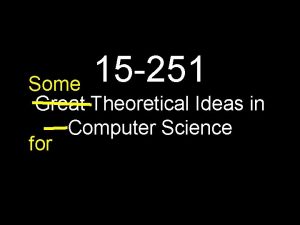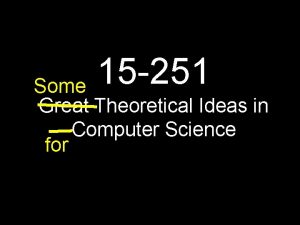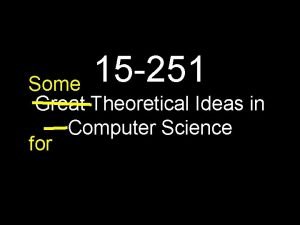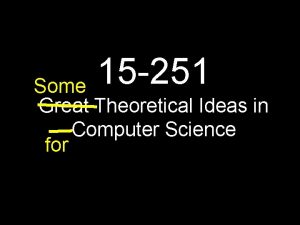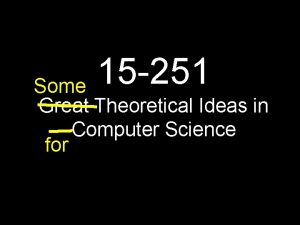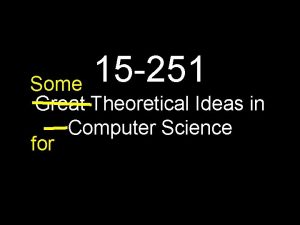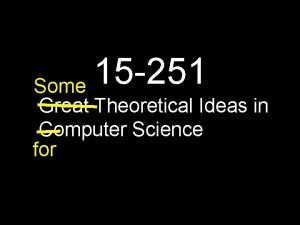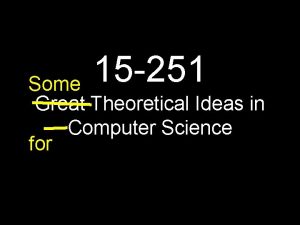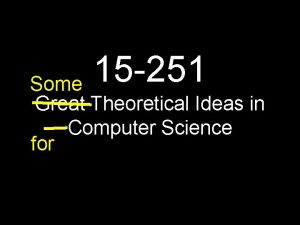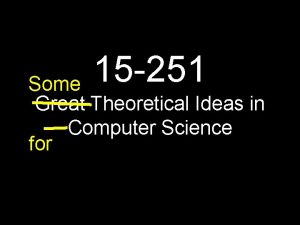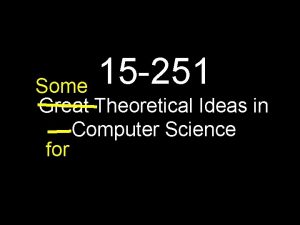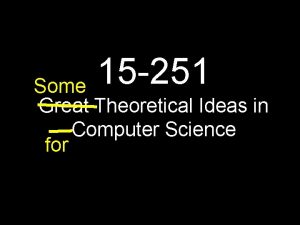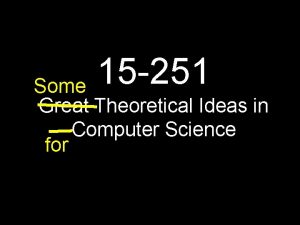15 251 Some Great Theoretical Ideas in Computer
















































- Slides: 48

15 -251 Some Great Theoretical Ideas in Computer Science for

Victor Adamchik Danny Sleator Graphs Lecture 18 (March 23, 2010)

Graph – informal definitions • Set of vertices (or nodes) • Set of edges, a pair of vertices • A self-loop is an edge that connects to the same vertex twice • A multi-edge is a set of two or more edges that have the same two vertices • A graph is simple if it has no multi-edges or self-loops.

More terms • • Cycles Paths The degree of a vertex Directed versus undirected (this lecture is all undirected)

What’s a tree? A tree is a connected graph with no cycles

Tree

Not Tree

Not Tree

Tree

How Many n-Node Trees? 1: 2: 3: 4: 5:

Notation In this lecture: n will denote the number of nodes in a graph e will denote the number of edges in a graph

Theorem: Let G be a graph with n nodes and e edges The following are equivalent: 1. G is a tree (connected, acyclic) 2. Every two nodes of G are joined by a unique path 3. G is connected and n = e + 1 4. G is acyclic and n = e + 1 5. G is acyclic and if any two non-adjacent nodes are joined by an edge, the resulting graph has exactly one cycle

To prove this, it suffices to show 1 2 3 4 5 1

1 2 1. G is a tree (connected, acyclic) 2. Every two nodes of G are joined by a unique path Proof: (by contradiction) Assume G is a tree that has two nodes connected by two different paths: Then there exists a cycle!

2 3 2. Every two nodes of G are joined by a unique path 3. G is connected and n = e + 1 Proof: (by induction) Assume true for every graph with < n nodes Let G have n nodes and let x and y be adjacent G 1 x y G 2 Let n 1, e 1 be number of nodes and edges in G 1 Then n = n 1 + n 2 = e 1 + e 2 + 2 = e + 1

3 4 3. G is connected and n = e + 1 4. G is acyclic and n = e + 1 Proof: (by contradiction) Assume G is connected with n = e + 1, and G has a cycle containing k nodes Note that the cycle has k nodes and k edges Start adding nodes and edges until you cover the whole graph Number of edges in the graph will be at least n

4 5 and 5 1 are left to the reader.

Corollary: Every nontrivial tree has at least two endpoints (points of degree 1) Proof (by contradiction): Assume all but one of the points in the tree have degree at least 2 In any graph, sum of the degrees = 2 e Then the total number of edges in the tree is at least (2 n-1)/2 = n - 1/2 > n - 1

How many labeled trees are there with three nodes? 1 2 3 1 3 2 2 1 3

How many labeled trees are there with four nodes? a c b d

How many labeled trees are there with five nodes? 5 labelings 5 x 4 x 3 labelings 125 labeled trees 5!/ 2 labelings

How many labeled trees are there with n nodes? 3 labeled trees with 3 nodes 16 labeled trees with 4 nodes 125 labeled trees with 5 nodes nn-2 labeled trees with n nodes

Cayley’s Formula The number of labeled trees on n nodes is nn-2

The proof will use the correspondence principle Each labeled tree on n nodes corresponds to A sequence in {1, 2, …, n}n-2 (that is, n-2 numbers, each in the range [1. . n])

How to make a sequence from a tree? Loop through i from 1 to n-2 Let L be the degree-1 node with the lowest label Define the ith element of the sequence as the label of the node adjacent to L Delete the node L from the tree Example: 5 1 8 4 3 2 6 1 3 3 4 4 4 7

Lemma: The node labels occurring in a sequence �are precisely those with degree at least 2. Proof: Every time a label is output, that node’s degree decreases by 1. At the end there are two nodes of degree 1. Therefore all the degree ≥ 2 are eventually output. ☐ Therefore, we can, by looking at the sequence, identify the nodes of degree 1. Among those, the one deleted first is the lowest. This leads to the following…. .

How to reconstruct the unique tree from a sequence S: Let I = {1, 2, 3, …, n} Loop until S is empty Let i = smallest # in I but not in S Let s = first label in sequence S Add edge {i, s} to the tree Delete i from I 5 Delete s from S 1 Add edge {a, b}, where I = {a, b} 8 4 3 2 6 1 3 3 4 4 4 7

For any sequence this algorithm always generates a labeled tree that inverts the encoding algorithm. The invariant that is preserved as the algorithm runs is that the set of available labels (l) always contains all the labels remaining in the sequence.

Spanning Trees A spanning tree of a graph G is a tree that touches every node of G and uses only edges from G Every connected graph has a spanning tree

A graph is planar if it can be drawn in the plane without crossing edges

Examples of Planar Graphs =

http: //www. planarity. net

Faces A planar graph splits the plane into disjoint faces 4 faces

Euler’s Formula If G is a connected planar graph with n vertices, e edges and f faces, then n–e+f=2

Rather than using induction, we’ll use the important notion of the dual graph Dual = put a node in every face, and an edge for each edge joining two adjacent faces

Let G* be the dual graph of G Let T be a spanning tree of G Let T* be the graph where there is an edge in dual graph for each edge in G – T Then T* is a spanning tree for G* n = e. T + 1 f = e. T* + 1 n + f = e. T + e. T* + 2 =e+2

Corollary: Let G be a simple planar graph with n > 2 vertices. Then: 1. G has a vertex of degree at most 5 2. G has at most 3 n – 6 edges Proof of 1: In any graph, (sum of degrees) = 2 e Assume all vertices have degree ≥ 6 Then 3 n ≤ e Furthermore, since G is simple, 3 f ≤ 2 e So 3 n + 3 f ≤ 3 e => 3(n-e+f) ≤ 0, contradict.

Graph Coloring A coloring of a graph is an assignment of a color to each vertex such that no neighboring vertices have the same color

Graph Coloring Arises surprisingly often in CS Register allocation: assign temporary variables to registers for scheduling instructions. Variables that interfere, or are simultaneously active, cannot be assigned to the same register

Theorem: Every planar graph can be 6 -colored Proof Sketch (by induction): Assume every planar graph with less than n vertices can be 6 -colored Assume G has n vertices Since G is planar, it has some node v with degree at most 5 Remove v and color by Induction Hypothesis

Not too difficult to give an inductive proof of 5 colorability, using same fact that some vertex has degree ≤ 5 4 -color theorem was finally proven in the 1970 s by Appel and Haken using computer assistance.

Implementing Graphs

Adjacency Matrix Suppose we have a graph G with n vertices. The adjacency matrix is the n x n matrix A=[aij] with: aij = 1 if (i, j) is an edge aij = 0 if (i, j) is not an edge Good for dense graphs!

Example A= 0111 1011 1101 1110

Counting Paths The number of paths of length k from node i to node j is the entry in position (i, j) in the matrix Ak A 2 = 0111 1011 1101 1110 = 3222 2322 2232 2223 0111 1011 1101 1110

Adjacency List Suppose we have a graph G with n vertices. The adjacency list is the list that contains all the nodes that each node is adjacent to Good for sparse graphs!

Example 1 3 2 4 1: 2, 3 2: 1, 3, 4 3: 1, 2, 4 4: 2, 3

Trees • Counting Trees • Different Characterizations Planar Graphs • Definition • Euler’s Theorem • Coloring Planar Graphs Here’s What You Need to Know… Adjacency Matrix and List • Definition • Useful for counting
 Great theoretical ideas in computer science
Great theoretical ideas in computer science Great ideas in theoretical computer science
Great ideas in theoretical computer science Great theoretical ideas in computer science
Great theoretical ideas in computer science Great theoretical ideas in computer science
Great theoretical ideas in computer science Great theoretical ideas in computer science
Great theoretical ideas in computer science Great theoretical ideas in computer science
Great theoretical ideas in computer science Steven rudich
Steven rudich Vocabularize
Vocabularize Great theoretical ideas in computer science
Great theoretical ideas in computer science Great theoretical ideas in computer science
Great theoretical ideas in computer science 8 ideas of computer architecture
8 ideas of computer architecture Great ideas in computer science
Great ideas in computer science Cs 61
Cs 61 8 great ideas in computer architecture
8 great ideas in computer architecture 8 great ideas in computer architecture
8 great ideas in computer architecture 15-251
15-251 Oh não consintas tristezas dentro do teu coração
Oh não consintas tristezas dentro do teu coração Stanford cs 251
Stanford cs 251 Half lap muff coupling drawing
Half lap muff coupling drawing 251 del 2000
251 del 2000 Cs 251 stanford
Cs 251 stanford Amedd commissioning programs
Amedd commissioning programs Cs 251 stanford
Cs 251 stanford Aae 251
Aae 251 Cse251
Cse251 15-251
15-251 In computer
In computer They say it only takes a little faith to move a mountain
They say it only takes a little faith to move a mountain God when you choose to leave mountains unmovable
God when you choose to leave mountains unmovable Ice cream countable
Ice cream countable Contact forces
Contact forces Some say the world will end in fire some say in ice
Some say the world will end in fire some say in ice Some say the world will end in fire some say in ice
Some say the world will end in fire some say in ice Some may trust in horses
Some may trust in horses Ideas have consequences bad ideas have victims
Ideas have consequences bad ideas have victims Ideas secundarias
Ideas secundarias China big idea
China big idea Turning great strategy into great performance
Turning great strategy into great performance North dakota state animal
North dakota state animal With leadership comes great responsibility
With leadership comes great responsibility Great white shark versus hammerhead shark
Great white shark versus hammerhead shark Did alexander the great deserve to be called great
Did alexander the great deserve to be called great Enlightened despot catherine
Enlightened despot catherine With great expectations comes great responsibility
With great expectations comes great responsibility A great deal vs a great many
A great deal vs a great many With great power comes great responsibility batman
With great power comes great responsibility batman Did alexander the great deserve to be called great
Did alexander the great deserve to be called great Great is thy faithfulness o lord my father
Great is thy faithfulness o lord my father Difference between a computer and computer system
Difference between a computer and computer system

